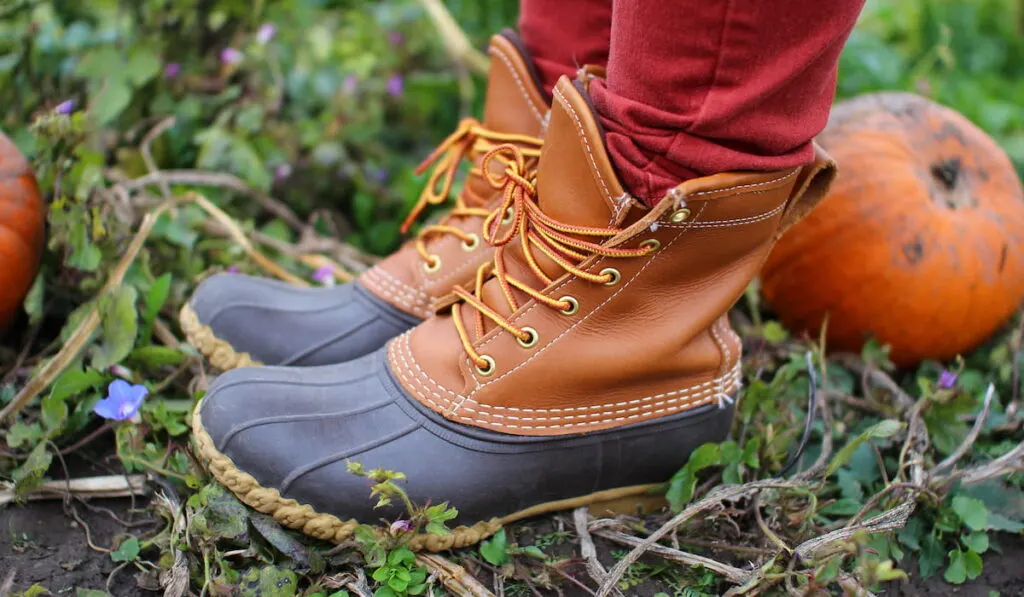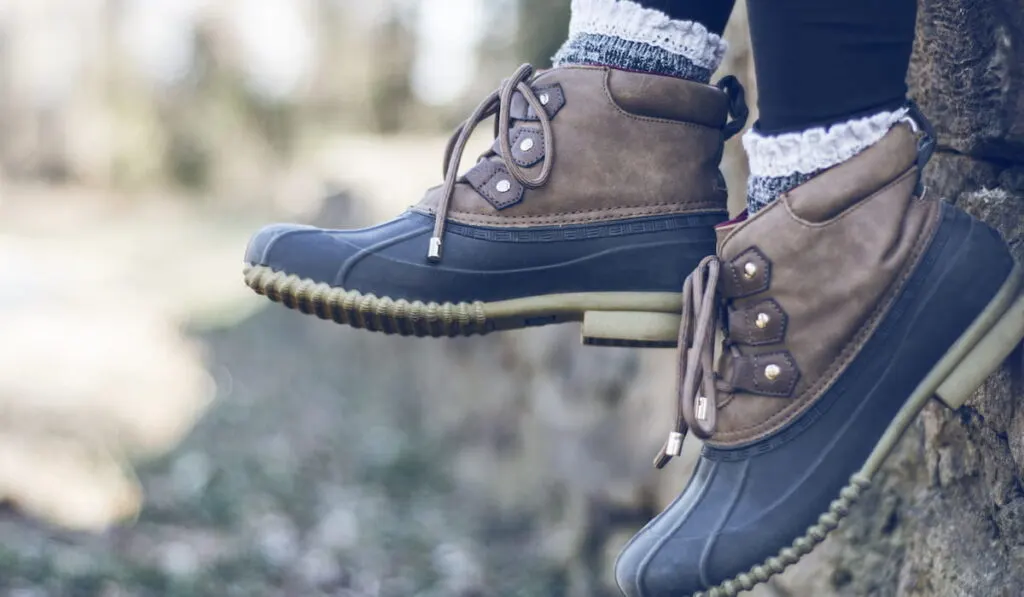Perhaps you are going on a hiking trip, and the closest thing to hiking boots that you have is duck boots. Since this type of shoe provides comfort and protection from water at the same time, you might be wondering if it is OK to use this type of shoe on your next hiking trip.
The question is, can you hike in duck boots?
Whether you can hike in duck boots depends on how long you are going to hike. Let’s say that you are going for a short hike that involves walking for a mile or two on wet or muddy ground, then duck boots will do just fine.
However, duck boots are not recommended for a long hike wherein you must walk on steep, uneven, or vertical terrain. This is because they lack traction, ankle support, and stability, which are standard in traditional hiking boots.

We’ll go deeper into this topic to help you understand more, but let’s take a look first at what duck boots are exactly.
Table of Contents
What Is a Duck Boot?
A duck boot is a waterproof shoe made of rubber and leather. Basically, they are a combination of rain boots and work boots.
These shoes were invented in 1911 in Freeport, Maine, by Leon Bean, an enthusiastic hunter whose goal was to create boots that would keep his feet dry and warm while on a hunt.
Duck boots have a rubber sole, allowing you to walk in mud and on wet surfaces safely. The sole also gives a little bit of solid grip in slippery areas.
On the other hand, the leather top provides flexibility and fashion.

Why Are Duck Boots Called Duck Boots?
As mentioned, Leon Bean created duck boots that would allow him to hunt comfortably. Originally, duck boots were called “Bean Boots.”
However, since duck hunters used these boots, they were eventually called duck boots.
Today, duck boots are used to hunt and can also be used in usual outdoor activities that involve walking in wet, muddy areas.
Reasons Why Duck Boots Are Good for Short Hikes
So what makes duck boots ideal for short hikes? Below are the reasons why:
Comfortable
Duck boots are comfortable because they are not as hard and heavy as traditional hiking boots.
Because of the leather upper, it will be easier to move and wiggle your toes inside, thus allowing you to move comfortably during your short hike.
The duck boot’s waterproof feature also provides comfort, as the water won’t penetrate inside your shoe, thus protecting your feet from wet, dirty, and cold water.
Convenient
Duck boots are easy to put on and remove mainly because they are made of flexible materials, unlike hiking boots which are made of rugged materials.
They are also more spacious, and you can easily tighten them with shoelaces after you put them on.
Duck boots are also easy to clean, thanks to their leather front.
Lightweight
While it is true that heavy hiking boots provide more protection when hiking, wearing such on a short hike may not be the most practical choice.
Meanwhile, duck boots are much lighter than traditional hiking boots. Wearing duck boots will allow you to move quickly, and they are easy to carry, too, thus saving you energy.
Waterproof
As mentioned before, duck boots are made of waterproof materials that protect your feet from wet, muddy trails.
Keeping your feet dry is important. If your feet get exposed to wet conditions for a prolonged period, that can negatively affect the nerves and skin.
Therefore, if you know that the short hiking trip will include walking on puddles, then wearing duck boots will be a good choice.

Reasons Why Duck Boots Aren’t a Good Choice for Long Hikes
Now, let’s talk about why you should not use duck boots on long hikes or those hikes wherein you need to walk for three miles or more.
Friction
While the spacious fitting of duck boots is beneficial for short hikes, it can be a drawback for long hikes. This is because the constant rubbing of your feet with the shoe causes friction, which, in the long run, can cause blisters.
And you probably know how painful it is to walk with a blister.
Lack of Ankle Support
Duck boots lack ankle support, especially when you climb narrow trails or walk on an uneven surface. Usually, your feet are flexed during these times, and duck boots cannot provide support for that position like hiking boots do.
Why is ankle support important, anyway?
Having proper ankle support greatly decreases the chance of you getting an injury because it limits the movement of your ankle while trekking or hiking on rough terrain.
Lack of Breathability
Because duck boots are waterproof, they lack breathability. While this shoe makes a decent option when hiking on muddy trails, this can be a problem when you are going to hike on dry ground on a hot summer day.
Since duck boots don’t have ventilation, your feet will eventually sweat and feel hot while hiking, which can be very uncomfortable and may also cause blisters.
But what if you’re going to hike during winter? The same thing will happen. Even in cold weather, your feet still need proper ventilation if you are going on long hiking trips.
Lack of Traction
Duck boots are specifically designed to withstand wet and slippery surfaces. Meanwhile, they lack the traction for dry, rocky, uphill terrain.
It can be very dangerous to hike with duck boots on steep inclines.
To climb such areas, you will need a shoe with good treads, such as standard hiking boots.
Can I Wear Duck Boots in Flooded Areas?
While duck boots are waterproof and, therefore, can be used in the rain and muddy areas, they are suitable for flooded areas. While the leather upper can resist water, it will eventually get wet if completely submerged for a long time.
Can I Wear Duck Boots in the Snow?
Duck boots make a great choice when you walk in the snow, provided that: first, the walk won’t take three miles or more; and second, the snow is not so deep that your boots get completely submerged.
Just like in flooded areas, the leather front of duck boots can get soaked with water when submerged in wet conditions for an extended period.
Conclusion
To wrap up, duck boots make a decent choice for short hiking trips, especially if you’re walking on a wet, muddy trail. They also come in various designs, which add to your fashion statement.
However, if you expect to walk more than three miles, use hiking boots. Remember, hiking is a fun and exciting activity, but it can easily be ruined if you do not equip yourself with the right gear, including your footwear.
Overall, duck boots make the best choice for hunting, but they are not recommended for long hiking trips.

